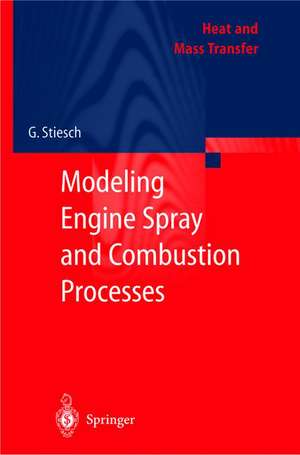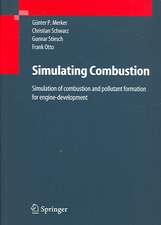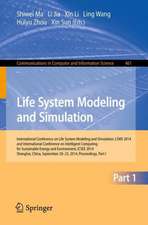Modeling Engine Spray and Combustion Processes: Heat and Mass Transfer
Autor Gunnar Stieschen Limba Engleză Hardback – 10 apr 2003
| Toate formatele și edițiile | Preț | Express |
|---|---|---|
| Paperback (1) | 987.17 lei 6-8 săpt. | |
| Springer Berlin, Heidelberg – 15 dec 2010 | 987.17 lei 6-8 săpt. | |
| Hardback (1) | 993.74 lei 6-8 săpt. | |
| Springer Berlin, Heidelberg – 10 apr 2003 | 993.74 lei 6-8 săpt. |
Din seria Heat and Mass Transfer
- 18%
 Preț: 1002.27 lei
Preț: 1002.27 lei - 15%
 Preț: 637.78 lei
Preț: 637.78 lei - 15%
 Preț: 647.92 lei
Preț: 647.92 lei - 15%
 Preț: 579.99 lei
Preț: 579.99 lei - 15%
 Preț: 649.39 lei
Preț: 649.39 lei - 18%
 Preț: 948.79 lei
Preț: 948.79 lei - 18%
 Preț: 990.44 lei
Preț: 990.44 lei - 18%
 Preț: 945.30 lei
Preț: 945.30 lei - 18%
 Preț: 887.24 lei
Preț: 887.24 lei - 15%
 Preț: 644.18 lei
Preț: 644.18 lei - 15%
 Preț: 645.28 lei
Preț: 645.28 lei - 18%
 Preț: 1236.19 lei
Preț: 1236.19 lei - 18%
 Preț: 950.96 lei
Preț: 950.96 lei - 18%
 Preț: 947.35 lei
Preț: 947.35 lei - 15%
 Preț: 636.12 lei
Preț: 636.12 lei - 18%
 Preț: 947.85 lei
Preț: 947.85 lei - 15%
 Preț: 639.41 lei
Preț: 639.41 lei - 18%
 Preț: 953.97 lei
Preț: 953.97 lei - 15%
 Preț: 640.88 lei
Preț: 640.88 lei - 15%
 Preț: 657.08 lei
Preț: 657.08 lei - 18%
 Preț: 957.62 lei
Preț: 957.62 lei - 18%
 Preț: 957.44 lei
Preț: 957.44 lei - 18%
 Preț: 943.25 lei
Preț: 943.25 lei - 18%
 Preț: 1049.44 lei
Preț: 1049.44 lei - 18%
 Preț: 955.70 lei
Preț: 955.70 lei - 15%
 Preț: 642.83 lei
Preț: 642.83 lei - 18%
 Preț: 1214.38 lei
Preț: 1214.38 lei - 15%
 Preț: 649.71 lei
Preț: 649.71 lei - 18%
 Preț: 950.66 lei
Preț: 950.66 lei - 15%
 Preț: 645.47 lei
Preț: 645.47 lei - 18%
 Preț: 1002.13 lei
Preț: 1002.13 lei - 15%
 Preț: 636.12 lei
Preț: 636.12 lei
Preț: 993.74 lei
Preț vechi: 1242.18 lei
-20% Nou
Puncte Express: 1491
Preț estimativ în valută:
190.18€ • 197.81$ • 157.00£
190.18€ • 197.81$ • 157.00£
Carte tipărită la comandă
Livrare economică 12-26 aprilie
Preluare comenzi: 021 569.72.76
Specificații
ISBN-13: 9783540006824
ISBN-10: 3540006826
Pagini: 304
Ilustrații: XV, 282 p.
Dimensiuni: 155 x 235 x 22 mm
Greutate: 0.6 kg
Ediția:2003
Editura: Springer Berlin, Heidelberg
Colecția Springer
Seria Heat and Mass Transfer
Locul publicării:Berlin, Heidelberg, Germany
ISBN-10: 3540006826
Pagini: 304
Ilustrații: XV, 282 p.
Dimensiuni: 155 x 235 x 22 mm
Greutate: 0.6 kg
Ediția:2003
Editura: Springer Berlin, Heidelberg
Colecția Springer
Seria Heat and Mass Transfer
Locul publicării:Berlin, Heidelberg, Germany
Public țintă
ResearchCuprins
1 Introduction.- 2 Thermodynamic Models.- 3 Phenomenological Models.- 4 Fundamentals of Multidimensional CFD-Codes.- 5 Multidimensional Models of Spray Processes.- 6 Multidimensional Combustion Models.- 7 Pollutant Formation.- 8 Conclusions.
Recenzii
MECHANICAL ENGINEERING
"In this volume, the author covers the various approaches to modeling in-cylinder processes, such as mixture formation, combustion, and formation of exhaust emissions in diesel and gasoline engines. Due to their complexity, emphasis is put on multidimensional spray, combustion, and emission formation models. However, phenomenological and zero-dimensional thermodynamic models, which are still widely used in engine development, are addressed as well. Example calculations of each model type are compared with corresponding experimental data in order to discuss the capabilities of today’s simulation models, as well as shortcomings that still exist. There is an overview of the most important simulation models describing the in-cylinder processes of internal combustion engines. In addition, suggestions are made about which modeling approach is appropriate for a specific type of problem."
"In this volume, the author covers the various approaches to modeling in-cylinder processes, such as mixture formation, combustion, and formation of exhaust emissions in diesel and gasoline engines. Due to their complexity, emphasis is put on multidimensional spray, combustion, and emission formation models. However, phenomenological and zero-dimensional thermodynamic models, which are still widely used in engine development, are addressed as well. Example calculations of each model type are compared with corresponding experimental data in order to discuss the capabilities of today’s simulation models, as well as shortcomings that still exist. There is an overview of the most important simulation models describing the in-cylinder processes of internal combustion engines. In addition, suggestions are made about which modeling approach is appropriate for a specific type of problem."
Textul de pe ultima copertă
The book covers the various approaches to modeling the in-cylinder processes such as mixture formation, combustion and formation of exhaust emissions in diesel and gasoline engines. Due to their complexity emphasis is put on multi-dimensional spray, combustion and emission formation models. However, phenomenological as well as zero-dimensional thermodynamic models, which are still widely used in engine development because of their computational efficiency, are addressed as well. Example calculations of each model type are compared with corresponding experimental data – represented in diagrams as well as in images resulting from modern optical measuring techniques – in order to discuss the capabilities of today's simulation models as well as the shortcomings that still exist either because of oversimplifying assumptions or because of insufficient knowledge of the real processes. The reader will be provided with an overview of the most important simulation models describing the in-cylinder processes of internal combustion engines. In addition, suggestions are made about which modeling approach is appropriate for a specific type of problem.
Caracteristici
Includes new combustion techniques such as direct injection spark ignition engines that require new modeling methods because of different injector designs and partially premixed combustion Includes the most recent and advanced computational models that have been developed during the last decade Includes supplementary material: sn.pub/extras












